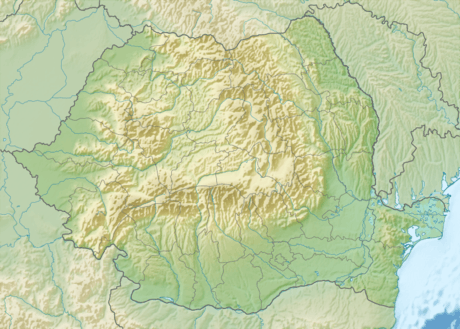1738 Vrancea earthquake
| Date | Wednesday, 31 May 1738 |
|---|---|
| Origin time | 11 a.m. |
| Duration | 15 minutes (including aftershocks) |
| Magnitude |
7.5 Ms[1] 7.7 Mw |
| Depth | 130 km[1] |
| Epicenter | 45°42′N 26°36′E / 45.7°N 26.6°ECoordinates: 45°42′N 26°36′E / 45.7°N 26.6°E |
| Areas affected |
|
| Max. intensity | 9.5 MSK[1][2] |
| Landslides | Yes |
| Foreshocks | 8 May 1738 |
| Casualties | Unknown |
The 1738 Vrancea earthquake occurred on 11 June [O.S. 31 May] 1738, during the third rule of Constantin Mavrocordat. The seism aroused great panic and is mentioned in several sources. It occurred in the lower lithospheric block, at a depth of 130 km. Its effects were violent on large areas, the hardest hit being Bucharest, where several houses and churches collapsed.
The Romanian territories were not the only affected. In Niš, a Serbian city where the Ottoman army was quartered, the fortresses on the Danube partially collapsed, and in the Greek Nicopolis four mosques collapsed.[3][4]
At an estimated magnitude of 7.7 on the Richter scale, the earthquake of 1738 is one of the strongest in the Romanian history.[1]
Foreshock
According to the catalog of Cornelius Radu, several foreshocks of magnitude 5–6 occurred starting with March 1738. In a chronicle is mentioned a "large" foreshock on 8 May 1738. It occurred at "5 o'clock", but its magnitude is not known.
Damage
The earthquake was felt especially in Bucharest, Iași, Focșani, Buzău and Sfântu Gheorghe. In Iași, 11 monasteries, 15 houses, 15 towers and a church steeple collapsed.[5] In the Carpathians, several rockslides occurred, a large one in the Buzău River Valley.[5] Significant damages were reported in citadels like Rupea, Șchei and Prejmer, where walls and defending towers were destroyed or severely damaged.[6] The seismic wave also affected the Neamț Citadel, where its thick walls collapsed.[7]
In the chronicle of Constantin Dapontes is mentioned that the walls of Princely Palace in Bucharest were cracked. In a book of hours appears that on 31 May the earth was shaken, and even "split and came out water with smell of gunpowder and brimstone". In the same book of hours is mentioned that many arches and walls of monasteries and houses in Bucharest were cracked, while "outside" churches and arches have collapsed. A Slavo-Romanian psalter gives information about the intensity of the earthquake: "the earth trembled in the month of May, on 31, midday, very strong, and went to the east and again turned backward. And the trees were shaking, like the wind, and has destroyed homes and the earth made great noise".[8]
In From yesterday Bucharest (Romanian: Din Bucureștii de ieri), George Potra reminds that the calamity "began with a great roaring". Many houses and churches were damaged and a "deep fracture" was open near Bucharest.[9]
Academician Gr. Ștefănescu wrote in a study published in 1901 that, during the earthquake in 1738, church bells began to ring themselves.
See also
- 1838 Vrancea earthquake, another major earthquake 100 years later in Vrancea seismic zone
- List of earthquakes in Vrancea County
References
- ↑ 1.0 1.1 1.2 1.3 "Seismicitatea României". National Institute for Earth Physics (in Romanian).
- ↑ Bică Andrei Gabriel (2013). "Vulnerabilitatea seismică a fondului construit din România la acțiunea cutremurelor vrâncene" (PDF). Technical University of Civil Engineering Bucharest (in Romanian).
- ↑ "Craiova - Cutremure". Vladimir Rosulescu - Istorie (in Romanian). 15 September 2011.
- ↑ Georgescu, Emil-Sever (1–6 August 2004). "Forensic engineering studies on historical earthquakes in Romania" (PDF). 13th World Conference on Earthquake Engineering. Vancouver.
- ↑ 5.0 5.1 "Istoria cutremurelor în România". Forpedia (in Romanian). 24 November 2010.
- ↑ Georgescu, Emil-Sever; Dobre, Daniela; Dragomir, Claudiu-Sorin; Borcia, Ioan Sorin. "Brașovul și seismele" (PDF). Roeduseis (in Romanian).
- ↑ Gabriel Păleanu (25 June 2011). "În România cutremurul catastrofal vine după 2041!". Cotidianul.ro (in Romanian).
- ↑ "Scurt istoric al cutremurelor majore produse în România". Antena 3 (in Romanian). 26 April 2009.
- ↑ Mândrescu, Neculai; Radulian, Mircea; Mărmureanu, Gheorghe; Grecu, Bogdan (16 October 2006). "Large Vrancea intermediate depth earthquakes and seismic microzonation of Bucharest urban area" (PDF). Horia Hulubei National Institute for R&D in Physics and Nuclear Engineering.
| ||||||||||||||||||

